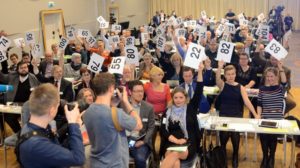Photo of the Vote in Norway for the Same-Sex Rite
Photo from article “Historic Decision on Church Weddings for Same-sex Couples“
The road was paved with compromises leading to the overwhelming majority decision for same-sex marriage liturgy at the General Synod of Church of Norway January 30. A year ago the preliminary decision was made, and now the new liturgy was accepted. The new liturgy became legal on February 1 and the first homosexual couple was married minutes after midnight on that same date.
What is the decision, and why would the bishops who were against same-sex marriages vote for it and agree to enforce it in every single congregation in Church of Norway?
The new liturgy is a non-gender specific liturgy to allow the marriage of people independent of gender. It is meant to be used for same-sex couples and heterosexual couples. The liturgy contains no reference to the biblical texts of marriage being between one man and one woman. The two are to say yes to their “spouse”, not to a “husband”/”man” or “wife/woman”. There are Scriptural passages that are optional readings, and among them are some relating to the marriage of man and woman.
The majority at the General Synod first insisted on only allowing this new liturgy and take the old one out of use. It became, however, a part of the compromise to allow the old liturgy with clear language of marriage between man and woman to still be allowed to be used — for the time being. This way the more conservative bishops hoped to create space for the group of pastors that have a classical understanding of marriage. There should be continued room for them even after the new same-sex, gender-irrelevant liturgy had been introduced.
But to achieve this compromise, the more conservative bishops agreed that all congregations in Norway must offer same-sex marriages. The local pastor can refuse to perform the same-sex marriage, but then another pastor will come in and perform the wedding. The compromise was agreed upon to avoid a split in the Church of Norway.
What can explain this rapid change in the Church of Norway where both Lutheranism and Pietism have experienced such a long and strong history? The Lutheran School of Theology (MF) was established in 1907 in reaction to the liberal theology of The School of Theology at the University. The pastors from this new Lutheran School of Theology became organized into the Fellowship for Bible and Confession (FBB in Norwegian). The irony is that today the vast majority of clergy in the Church of Norway are educated at MF, and all the bishops are educated at MF, and many of today’s liberals once were members of the FBB, some of them even were board members and chairmen.
The theological change is obviously from within the church, but the speed of change is due to external pressure. The Church of Norway is as of January 1, 2017 separate from the State. But the politicians did not allow the Church of Norway to receive independence without some system to secure liberal development in the church.
One change is the request for high voter attendance when electing delegates to the General Synod. Formerly the elections, in effect, allowed those worshiping to have more influence since they were present at the worship services where the elections were held. Now the elections happened together with the national political elections.
At the same time, a group of ultra-liberals organized themselves, designed a program with the intention to take control of the church and did lobbied to get state funds to finance their operation. Other groups with different agendas did not receive money when they applied.
The public campaign from the ultra-liberals was strong. The aim was to convince the 73% of Norwegians who had voting rights at political elections and also were members of the Church of Norway to vote for one of the liberal candidates for the General Synod. It changed the game. Now you could vote without going to church. Now you no longer have to be among the 2 percent of church members who attend the Sunday worship service in order to vote. Remember, there is no requirement for a delegate to the General Synod to adhere to the Lutheran confessions of the church. You don’t even have to believe in God, and don’t have to ever attend church.
The result of the election was overwhelming. A total majority at the General Synod implied a full control of the Church of Norway. The majority at General Synod implies that one decides the liturgy of the church and elects the National Church board. The ultra-liberal majority of the Synod put the ultra-liberals in complete majority control of the National Church board that elects the bishops.
When the decision on same-sex rite was decided at the General Synod about 1300 people resigned from membership in Church of Norway using the electronic on line service you can use both to resign and to become member. The people resigning were some of the core people in local congregations in Church of Norway, including some pastors.
Torkild Masvie
Provisional bishop
The Lutheran Church in Norway

